2013 FORD F250 warning
[x] Cancel search: warningPage 19 of 577
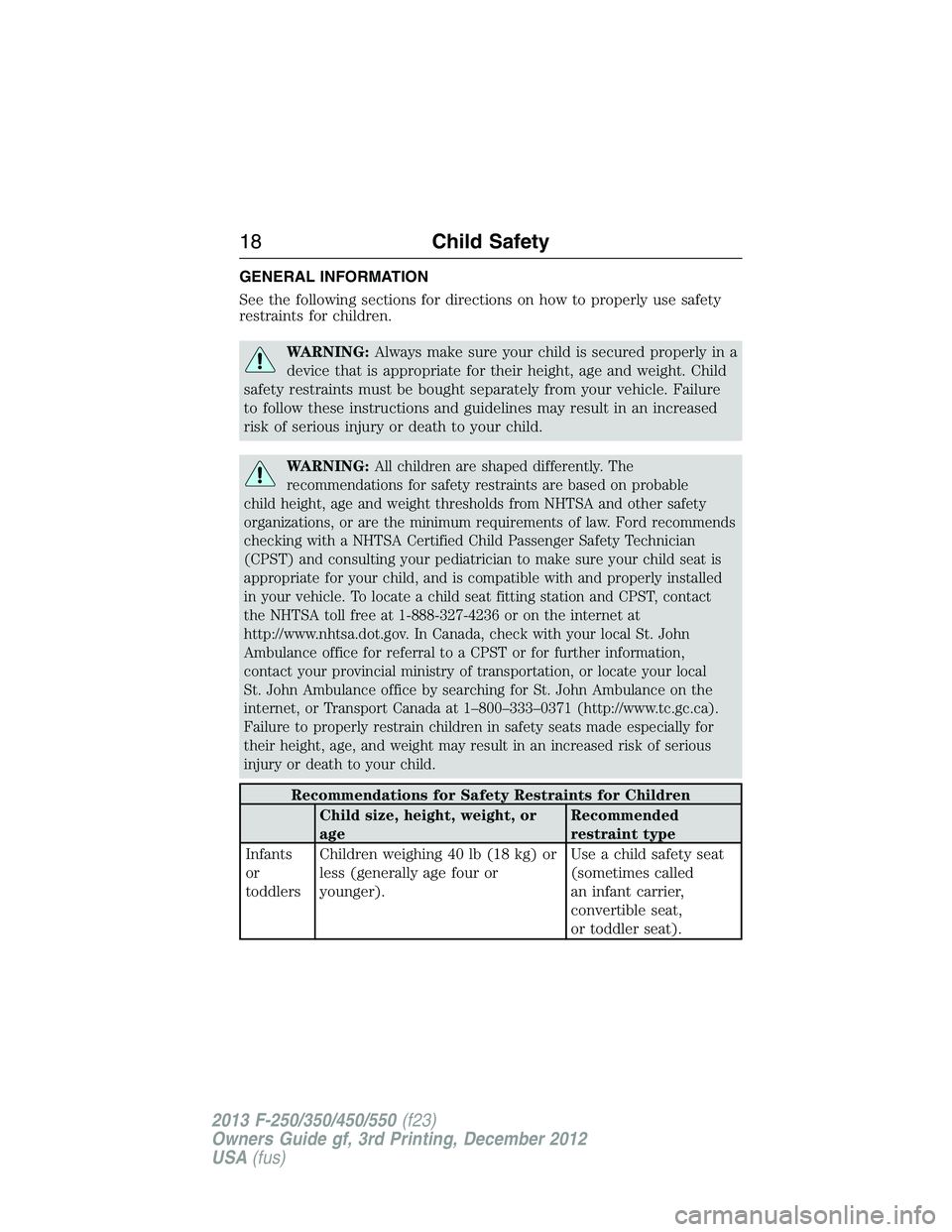
GENERAL INFORMATION
See the following sections for directions on how to properly use safety
restraints for children.
WARNING:Always make sure your child is secured properly in a
device that is appropriate for their height, age and weight. Child
safety restraints must be bought separately from your vehicle. Failure
to follow these instructions and guidelines may result in an increased
risk of serious injury or death to your child.
WARNING:All children are shaped differently. The
recommendations for safety restraints are based on probable
child height, age and weight thresholds from NHTSA and other safety
organizations, or are the minimum requirements of law. Ford recommends
checking with a NHTSA Certified Child Passenger Safety Technician
(CPST) and consulting your pediatrician to make sure your child seat is
appropriate for your child, and is compatible with and properly installed
in your vehicle. To locate a child seat fitting station and CPST, contact
the NHTSA toll free at 1-888-327-4236 or on the internet at
http://www.nhtsa.dot.gov. In Canada, check with your local St. John
Ambulance office for referral to a CPST or for further information,
contact your provincial ministry of transportation, or locate your local
St. John Ambulance office by searching for St. John Ambulance on the
internet, or Transport Canada at 1–800–333–0371 (http://www.tc.gc.ca).
Failure to properly restrain children in safety seats made especially for
their height, age, and weight may result in an increased risk of serious
injury or death to your child.
Recommendations for Safety Restraints for Children
Child size, height, weight, or
ageRecommended
restraint type
Infants
or
toddlersChildren weighing 40 lb (18 kg) or
less (generally age four or
younger).Use a child safety seat
(sometimes called
an infant carrier,
convertible seat,
or toddler seat).
18Child Safety
2013 F-250/350/450/550(f23)
Owners Guide gf, 3rd Printing, December 2012
USA(fus)
Page 21 of 577
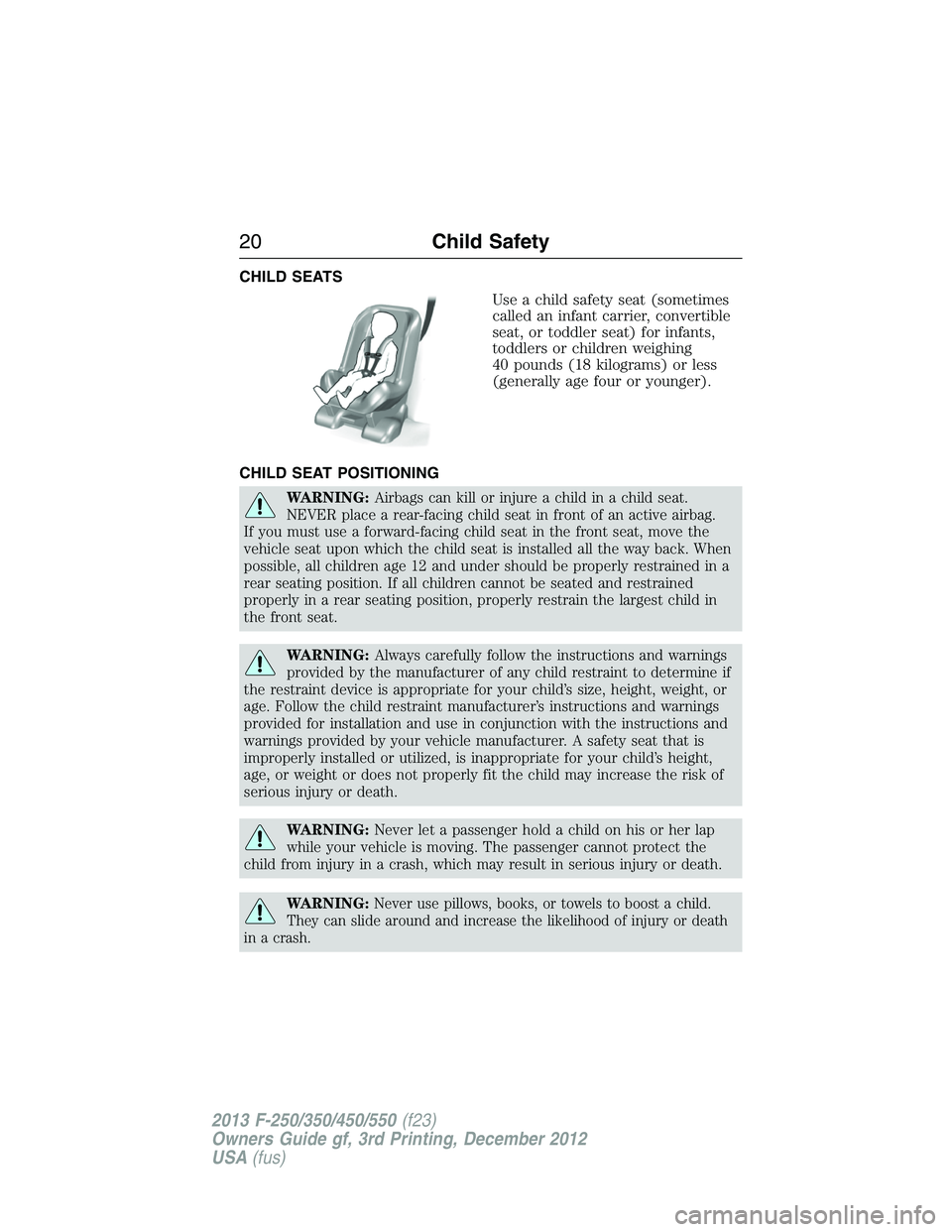
CHILD SEATS
Use a child safety seat (sometimes
called an infant carrier, convertible
seat, or toddler seat) for infants,
toddlers or children weighing
40 pounds (18 kilograms) or less
(generally age four or younger).
CHILD SEAT POSITIONING
WARNING:Airbags can kill or injure a child in a child seat.
NEVER place a rear-facing child seat in front of an active airbag.
If you must use a forward-facing child seat in the front seat, move the
vehicle seat upon which the child seat is installed all the way back. When
possible, all children age 12 and under should be properly restrained in a
rear seating position. If all children cannot be seated and restrained
properly in a rear seating position, properly restrain the largest child in
the front seat.
WARNING:Always carefully follow the instructions and warnings
provided by the manufacturer of any child restraint to determine if
the restraint device is appropriate for your child’s size, height, weight, or
age. Follow the child restraint manufacturer’s instructions and warnings
provided for installation and use in conjunction with the instructions and
warnings provided by your vehicle manufacturer. A safety seat that is
improperly installed or utilized, is inappropriate for your child’s height,
age, or weight or does not properly fit the child may increase the risk of
serious injury or death.
WARNING:Never let a passenger hold a child on his or her lap
while your vehicle is moving. The passenger cannot protect the
child from injury in a crash, which may result in serious injury or death.
WARNING:Never use pillows, books, or towels to boost a child.
They can slide around and increase the likelihood of injury or death
in a crash.
20Child Safety
2013 F-250/350/450/550(f23)
Owners Guide gf, 3rd Printing, December 2012
USA(fus)
Page 22 of 577
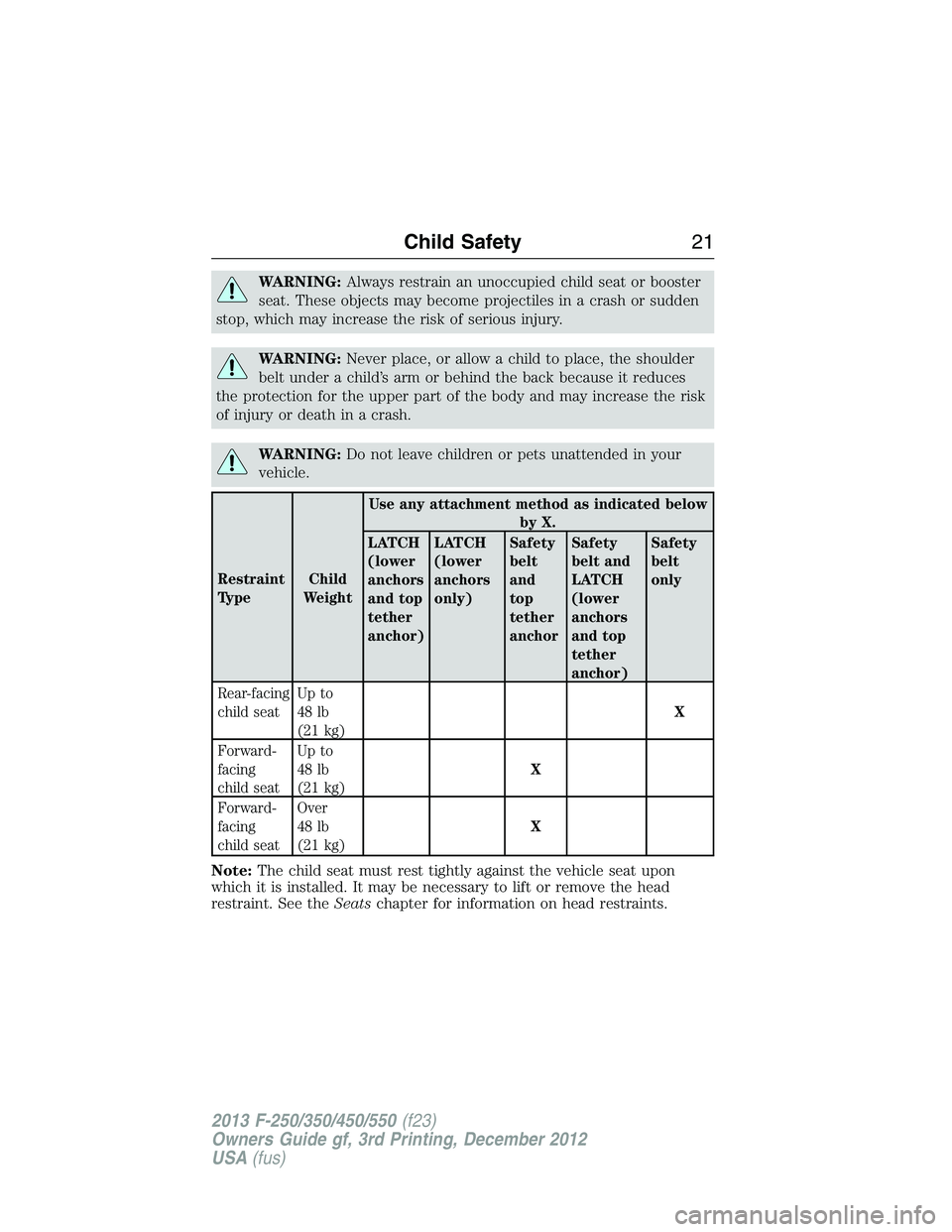
WARNING:Always restrain an unoccupied child seat or booster
seat. These objects may become projectiles in a crash or sudden
stop, which may increase the risk of serious injury.
WARNING:Never place, or allow a child to place, the shoulder
belt under a child’s arm or behind the back because it reduces
the protection for the upper part of the body and may increase the risk
of injury or death in a crash.
WARNING:Do not leave children or pets unattended in your
vehicle.
Restraint
TypeChild
WeightUse any attachment method as indicated below
by X.
LATCH
(lower
anchors
and top
tether
anchor)LATCH
(lower
anchors
only)Safety
belt
and
top
tether
anchorSafety
belt and
LATCH
(lower
anchors
and top
tether
anchor)Safety
belt
only
Rear-facing
child seatUp to
48 lb
(21 kg)X
Forward-
facing
child seatUp to
48 lb
(21 kg)X
Forward-
facing
child seatOver
48 lb
(21 kg)X
Note:The child seat must rest tightly against the vehicle seat upon
which it is installed. It may be necessary to lift or remove the head
restraint. See theSeatschapter for information on head restraints.
Child Safety21
2013 F-250/350/450/550(f23)
Owners Guide gf, 3rd Printing, December 2012
USA(fus)
Page 23 of 577
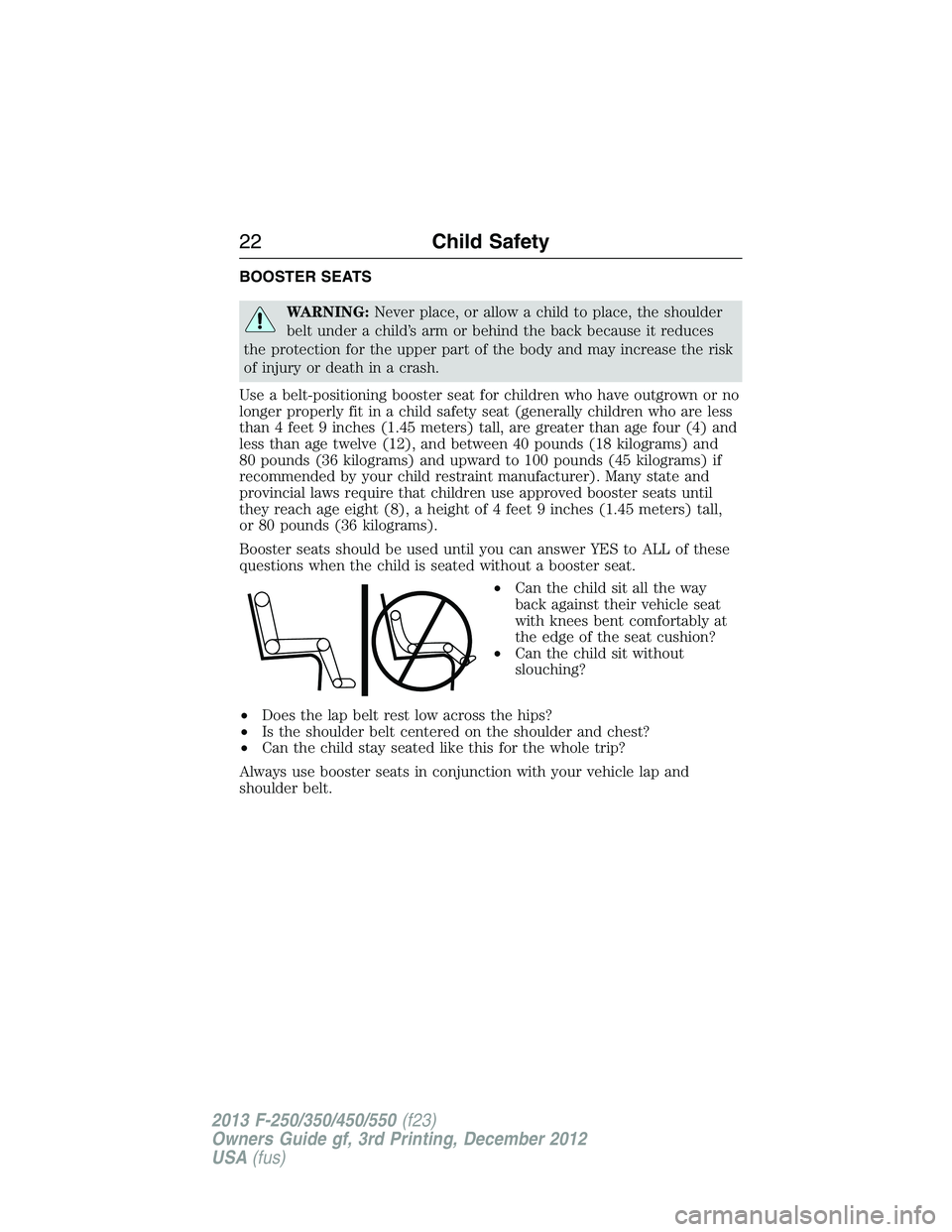
BOOSTER SEATS
WARNING:Never place, or allow a child to place, the shoulder
belt under a child’s arm or behind the back because it reduces
the protection for the upper part of the body and may increase the risk
of injury or death in a crash.
Use a belt-positioning booster seat for children who have outgrown or no
longer properly fit in a child safety seat (generally children who are less
than 4 feet 9 inches (1.45 meters) tall, are greater than age four (4) and
less than age twelve (12), and between 40 pounds (18 kilograms) and
80 pounds (36 kilograms) and upward to 100 pounds (45 kilograms) if
recommended by your child restraint manufacturer). Many state and
provincial laws require that children use approved booster seats until
they reach age eight (8), a height of 4 feet 9 inches (1.45 meters) tall,
or 80 pounds (36 kilograms).
Booster seats should be used until you can answer YES to ALL of these
questions when the child is seated without a booster seat.
•Can the child sit all the way
back against their vehicle seat
with knees bent comfortably at
the edge of the seat cushion?
•Can the child sit without
slouching?
•Does the lap belt rest low across the hips?
•Is the shoulder belt centered on the shoulder and chest?
•Can the child stay seated like this for the whole trip?
Always use booster seats in conjunction with your vehicle lap and
shoulder belt.
22Child Safety
2013 F-250/350/450/550(f23)
Owners Guide gf, 3rd Printing, December 2012
USA(fus)
Page 26 of 577
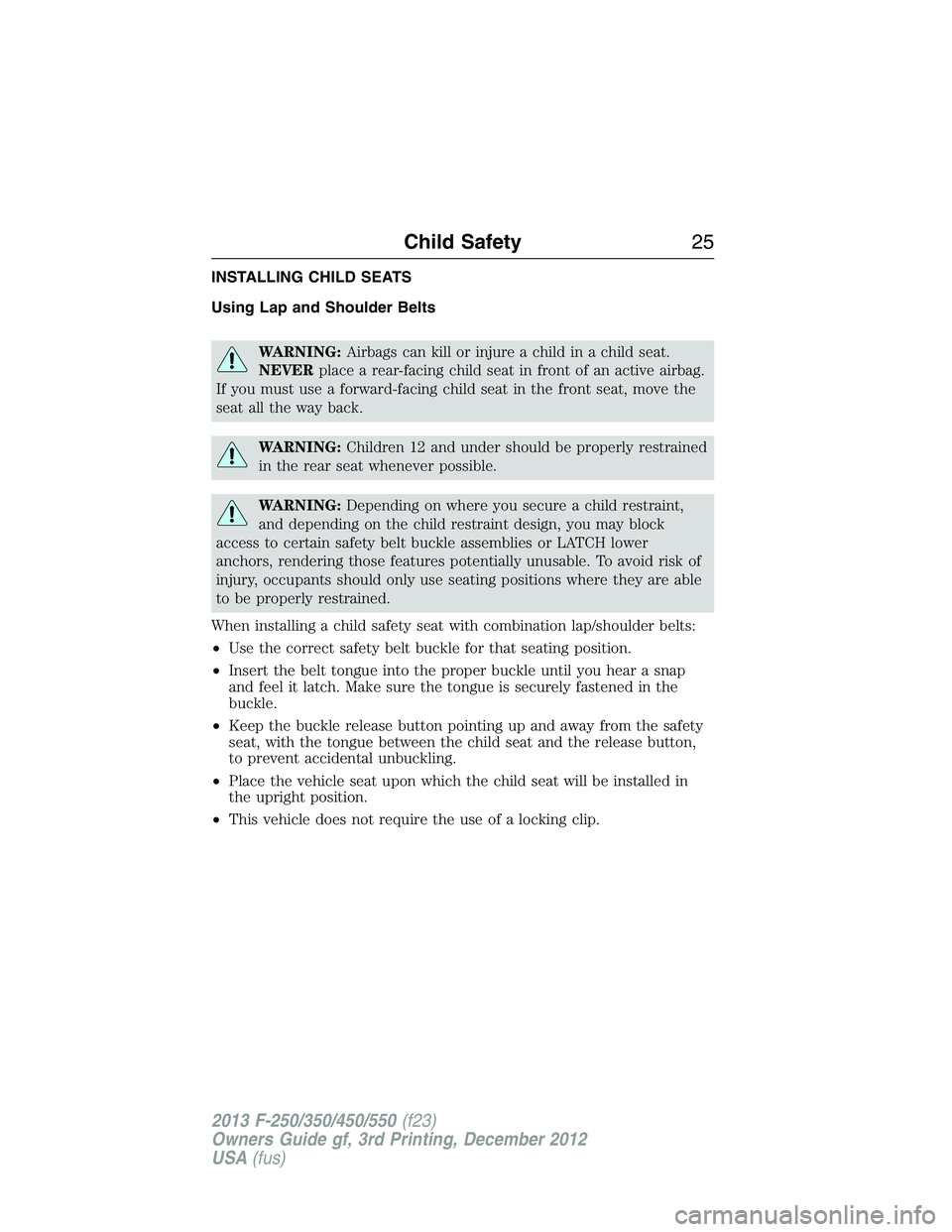
INSTALLING CHILD SEATS
Using Lap and Shoulder Belts
WARNING:Airbags can kill or injure a child in a child seat.
NEVERplace a rear-facing child seat in front of an active airbag.
If you must use a forward-facing child seat in the front seat, move the
seat all the way back.
WARNING:Children 12 and under should be properly restrained
in the rear seat whenever possible.
WARNING:Depending on where you secure a child restraint,
and depending on the child restraint design, you may block
access to certain safety belt buckle assemblies or LATCH lower
anchors, rendering those features potentially unusable. To avoid risk of
injury, occupants should only use seating positions where they are able
to be properly restrained.
When installing a child safety seat with combination lap/shoulder belts:
•Use the correct safety belt buckle for that seating position.
•Insert the belt tongue into the proper buckle until you hear a snap
and feel it latch. Make sure the tongue is securely fastened in the
buckle.
•Keep the buckle release button pointing up and away from the safety
seat, with the tongue between the child seat and the release button,
to prevent accidental unbuckling.
•Place the vehicle seat upon which the child seat will be installed in
the upright position.
•This vehicle does not require the use of a locking clip.
Child Safety25
2013 F-250/350/450/550(f23)
Owners Guide gf, 3rd Printing, December 2012
USA(fus)
Page 29 of 577
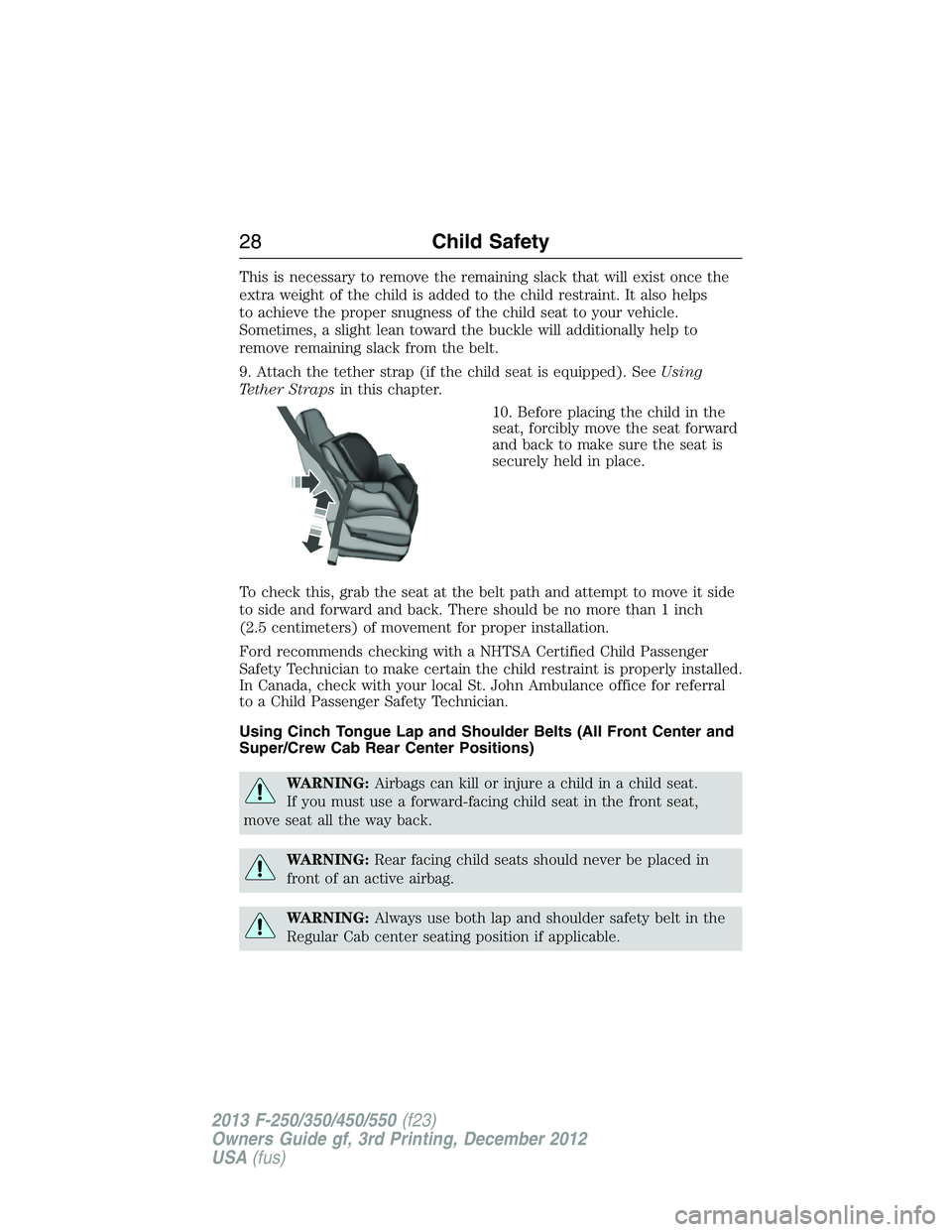
This is necessary to remove the remaining slack that will exist once the
extra weight of the child is added to the child restraint. It also helps
to achieve the proper snugness of the child seat to your vehicle.
Sometimes, a slight lean toward the buckle will additionally help to
remove remaining slack from the belt.
9. Attach the tether strap (if the child seat is equipped). SeeUsing
Tether Strapsin this chapter.
10. Before placing the child in the
seat, forcibly move the seat forward
and back to make sure the seat is
securely held in place.
To check this, grab the seat at the belt path and attempt to move it side
to side and forward and back. There should be no more than 1 inch
(2.5 centimeters) of movement for proper installation.
Ford recommends checking with a NHTSA Certified Child Passenger
Safety Technician to make certain the child restraint is properly installed.
In Canada, check with your local St. John Ambulance office for referral
to a Child Passenger Safety Technician.
Using Cinch Tongue Lap and Shoulder Belts (All Front Center and
Super/Crew Cab Rear Center Positions)
WARNING:Airbags can kill or injure a child in a child seat.
If you must use a forward-facing child seat in the front seat,
move seat all the way back.
WARNING:Rear facing child seats should never be placed in
front of an active airbag.
WARNING:Always use both lap and shoulder safety belt in the
Regular Cab center seating position if applicable.
28Child Safety
2013 F-250/350/450/550(f23)
Owners Guide gf, 3rd Printing, December 2012
USA(fus)
Page 37 of 577
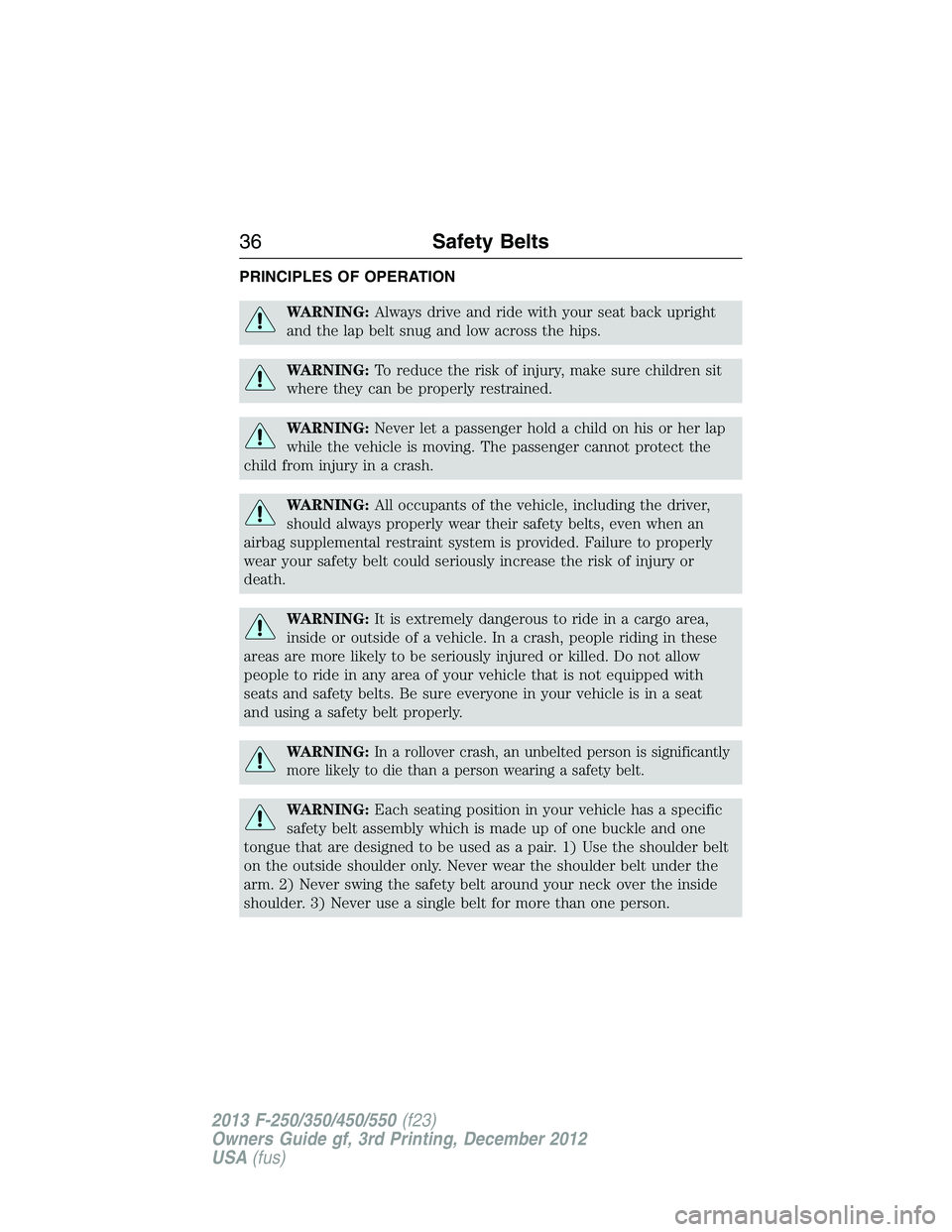
PRINCIPLES OF OPERATION
WARNING:Always drive and ride with your seat back upright
and the lap belt snug and low across the hips.
WARNING:To reduce the risk of injury, make sure children sit
where they can be properly restrained.
WARNING:Never let a passenger hold a child on his or her lap
while the vehicle is moving. The passenger cannot protect the
child from injury in a crash.
WARNING:All occupants of the vehicle, including the driver,
should always properly wear their safety belts, even when an
airbag supplemental restraint system is provided. Failure to properly
wear your safety belt could seriously increase the risk of injury or
death.
WARNING:It is extremely dangerous to ride in a cargo area,
inside or outside of a vehicle. In a crash, people riding in these
areas are more likely to be seriously injured or killed. Do not allow
people to ride in any area of your vehicle that is not equipped with
seats and safety belts. Be sure everyone in your vehicle is in a seat
and using a safety belt properly.
WARNING:In a rollover crash, an unbelted person is significantly
more likely to die than a person wearing a safety belt.
WARNING:Each seating position in your vehicle has a specific
safety belt assembly which is made up of one buckle and one
tongue that are designed to be used as a pair. 1) Use the shoulder belt
on the outside shoulder only. Never wear the shoulder belt under the
arm. 2) Never swing the safety belt around your neck over the inside
shoulder. 3) Never use a single belt for more than one person.
36Safety Belts
2013 F-250/350/450/550(f23)
Owners Guide gf, 3rd Printing, December 2012
USA(fus)
Page 38 of 577

WARNING:When possible, all children 12 years old and under
should be properly restrained in a rear seating position. Failure
to follow this could seriously increase the risk of injury or death.
WARNING:Safety belts and seats can become hot in a vehicle
that has been closed up in sunny weather; they could burn a
small child. Check seat covers and buckles before you place a child
anywhere near them.
WARNING:Front and rear seat occupants, including pregnant
women, should wear safety belts for optimum protection in an
accident.
All seating positions in this vehicle have lap and shoulder safety belts.
All occupants of the vehicle should always properly wear their safety
belts, even when an airbag supplemental restraint system is provided.
The safety belt system consists of:
•lap and shoulder safety belts.
•shoulder safety belt with automatic locking mode, (except driver
safety belt).
•height adjuster at the front outboard seating positions
•safety belt pretensioner at the front outboard seating positions.
•Safety belt warning light and chime. SeeSafety Belt
Warning Light and Indicator Chimelater in this chapter.
•Crash sensors and monitoring system with readiness
indicator. SeeCrash Sensors and Airbag Indicatorin the
Supplemental Restraints Systemchapter.
The safety belt pretensioners are designed to activate in frontal,
near-frontal and side crashes, and in rollovers. The safety belt
pretensioners at the front seating positions are designed to tighten the
safety belts firmly against the occupant’s body when activated. This helps
increase the effectiveness of the safety belts. In frontal crashes, the safety
belt pretensioners can be activated alone or, if the crash is of sufficient
severity, together with the front airbags.
Safety Belts37
2013 F-250/350/450/550(f23)
Owners Guide gf, 3rd Printing, December 2012
USA(fus)